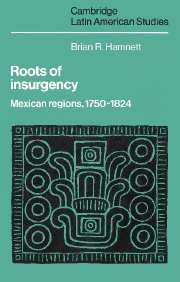Book contents
- Frontmatter
- Contents
- List of maps
- Acknowledgements
- Weights and measures
- Map 1 The viceroyalty of New Spain in 1810
- Introduction
- 1 Social tensions in the provinces
- 2 Insurgency — characteristics and responses
- 3 Conflict, protest and rebellion
- 4 Dearth and dislocation
- 5 Insurrection — recruitment and extension
- 6 The struggle for Puebla,1811–13
- 7 Local conflict and provincial chieftains
- 8 Conclusion
- Notes
- Bibliography
- Index
- CAMBRIDGE LATIN AMERICAN STUDIES
7 - Local conflict and provincial chieftains
Published online by Cambridge University Press: 20 October 2009
- Frontmatter
- Contents
- List of maps
- Acknowledgements
- Weights and measures
- Map 1 The viceroyalty of New Spain in 1810
- Introduction
- 1 Social tensions in the provinces
- 2 Insurgency — characteristics and responses
- 3 Conflict, protest and rebellion
- 4 Dearth and dislocation
- 5 Insurrection — recruitment and extension
- 6 The struggle for Puebla,1811–13
- 7 Local conflict and provincial chieftains
- 8 Conclusion
- Notes
- Bibliography
- Index
- CAMBRIDGE LATIN AMERICAN STUDIES
Summary
The Villagrán, the Osorno, the Galeana, the Bravo — these clans we have already encountered. They were among the many that operated during the insurgency, several, if not most of them, thrown into prominence by the war itself. Perhaps the two most celebrated in their particular regions at the time were Albino García and Gordiano Guzmán. Certainly not far behind would be Pedro Moreno, “El Amo” Torres, Manuel Muñiz, Encarnación Rosas, P. Luciano Navarrete, Miguel Borja, or P. Miguel Torres. There were many more. They signified the early and irreversible fragmentation of command within the insurgent camp. A comparable decentralisation took place within government-held territory. The division of the viceroyalty into warring zones broke apart the hierarchy of command that had characterised colonial rule, and pushed the hitherto predominant civilian administrator into the background. Despite Viceroy Calleja's efforts to retain central control, military commanders in the regions took virtually autonomous actions. This de facto regionalisation of authority left unprotected the exposed border zones, generally of difficult terrain, between the provinces. Rebel chieftains continued to thrive for long periods in such areas. Ineffective government control on the perimeters of one province left neighbouring provinces exposed to rekindled insurgent action. As a result, military commanders frequently did not know which direction to face. Their problem, as they saw it, was continually one of insufficient manpower.
Local chieftains and provincial commanders, whether Royalist or insurgent, or oscillating between sides, represented, at the most blatant, the rule of force.
- Type
- Chapter
- Information
- Roots of InsurgencyMexican Regions, 1750–1824, pp. 178 - 201Publisher: Cambridge University PressPrint publication year: 1986



